Simulation and Evaluation of Rainwater Runoff Control, Collection, and Utilization for Sponge City Reconstruction in an Urban Residential Community
Abstract
:1. Introduction
2. Materials and Methods
2.1. Research Method Flow
2.2. Research Area
2.3. Sponge Community Reconstruction Measures
2.4. Simulation Model and Methods
2.5. Rainfall Data
3. Model Building and Parameter Selection
3.1. SWMM Model Establishment and Catchment Division
3.2. Model Parameter Selection
3.3. Evaluation Index Calculation
4. Results
4.1. Runoff Reduction Rate
4.1.1. Water Depth of Outlet Pipe
4.1.2. Outlet Flow and Reduction Rate
4.2. Rainwater Storage Rate
4.3. Rainwater Utilization Rate
5. Discussion
6. Conclusions
Author Contributions
Funding
Institutional Review Board Statement
Informed Consent Statement
Data Availability Statement
Conflicts of Interest
References
- Liu, H.; Jia, Y.; Niu, C. “Sponge city” concept helps solve China’s urban water problems. Environ. Earth Sci. 2017, 76, 1–15. [Google Scholar] [CrossRef]
- Zhou, J.; Liu, J.; Yan, D.; Wang, H.; Wang, Z.; Shao, W.; Luan, Y. Dissipation of water in urban area, mechanism and modelling with the consideration of anthropogenic impacts: A case study in Xiamen. J. Hydrol. 2019, 570, 356. [Google Scholar] [CrossRef]
- Schreider, S.Y.; Smith, D.I.; Jakeman, A.J. Climate Change Impacts on Urban Flooding. Clim. Chang. 2000, 47, 91–115. [Google Scholar] [CrossRef]
- Kermanshah, A.; Derrible, S.; Berkelhammer, M. Using Climate Models to Estimate Urban Vulnerability to Flash Floods. J. Appl. Meteorol. Clim. 2017, 56, 2637–2650. [Google Scholar] [CrossRef]
- Wang, X.; Kinsland, G.; Poudel, D.; Fenech, A. Urban flood prediction under heavy precipitation. J. Hydrol. 2019, 577, 123984. [Google Scholar] [CrossRef]
- Hu, M.; Zhang, X.; Li, Y.; Yang, H.; Tanaka, K. Flood mitigation performance of low impact development technologies under different storms for retrofitting an urbanized area. J. Clean Prod. 2019, 222, 373–380. [Google Scholar] [CrossRef]
- Wang, H.; Zhou, J.; Tang, Y.; Liu, Z.; Kang, A.; Chen, B. Flood economic assessment of structural measure based on integrated flood risk management: A case study in Beijing. J. Environ. Manag. 2021, 280, 111701. [Google Scholar] [CrossRef]
- Zhang, S.; Li, Y.; Ma, M.; Song, T.; Song, R. Storm Water Management and Flood Control in Sponge City Construction of Beijing. Water 2018, 10, 1040. [Google Scholar] [CrossRef]
- Zhang, S.; Zhang, J.; Yue, T.; Jing, X. Impacts of climate change on urban rainwater harvesting systems. Sci. Total Environ. 2019, 665, 262–274. [Google Scholar] [CrossRef]
- Liu, W.; Chen, W.; Peng, C.; Wu, L.; Qian, Y. A water balance approach to assess rainwater availability potential in urban areas: The case of Beijing, China. Water Supply 2015, 15, 490–498. [Google Scholar] [CrossRef] [Green Version]
- Chen, W.; Gao, S. Research on Rainwater Management from the Perspective of Sponge City. IOP Conf. Ser. Earth Environ. Sci. 2019, 252, 32064. [Google Scholar] [CrossRef]
- De Sá Silva, A.C.R.; Bimbato, A.M.; Balestieri, J.A.P.; Vilanova, M.R.N. Exploring environmental, economic and social aspects of rainwater harvesting systems: A review. Sustain. Cities Soc. 2022, 76, 103475. [Google Scholar] [CrossRef]
- Zhou, J.; Liu, J.; Shao, W.; Yu, Y.; Zhang, K.; Wang, Y.; Mei, C. Effective Evaluation of Infiltration and Storage Measures in Sponge City Construction: A Case Study of Fenghuang City. Water 2018, 10, 937. [Google Scholar] [CrossRef]
- China Ministry of Housing and Urban-Rural Construction (MHURC). Technical Guide for Sponge City Construction—Construction of Rain Water System for Low Impact Development; MHURC: Beijing, China, 2014; p. 88. [Google Scholar]
- Li, Q.; Wang, F.; Yu, Y.; Huang, Z.; Li, M.; Guan, Y. Comprehensive performance evaluation of LID practices for the sponge city construction: A case study in Guangxi, China. J. Environ. Manag. 2019, 231, 10–20. [Google Scholar] [CrossRef] [PubMed]
- Chi, Y.; Bai, G.; Dong, H. A New Multicriteria Decision-Making Method for the Selection of Sponge City Schemes with Shapley—Choquet Aggregation Operators. Math. Probl. Eng. 2021, 2021, 1–16. [Google Scholar] [CrossRef]
- You, L.; Xu, T.; Mao, X.; Jia, H.; Wre, D. Site-Scale LID-BMPs Planning and Optimization in Residential Areas. J. Sustain. Water Built Environ. 2018, 5018001–5018004. [Google Scholar] [CrossRef]
- Jianshi, L.; Jing, Y.; Hao, Z. The Control Index for the Construction of Sponge City in the Residential Area: A Case Study of Nanjing Jiangbei New District. J. Environ. Public Health 2022, 2022, 2209161. [Google Scholar] [CrossRef]
- Jiayu, H.; Manhua, L.; Yang, S. Research on Residential Quarters Based on the Concept of Sponge City. Sci. Discov. 2019, 7, 385–389. [Google Scholar] [CrossRef]
- Shen, J.; Ma, G.; Chun, T. Optimized Design of Hard Landscape in Residential Area Under the Concept of Sponge City—A Case Study of Road Planning and Buildings’ Aprons. In Proceedings of the 2015 International Conference on Education, Management and Systems Engineering (EMSE 2015), Phuket, Thailand, 23 August 2015; pp. 222–225. [Google Scholar]
- Hou, J.; Wang, X.; Li, B.; Gao, X.; Huang, M.; Han, H.; Shen, R. Refined Simulation Method of the Rainfall—Runoff Processes in a Residential Area with LID Measures. J. Hydrol. Eng. 2021, 26, 4021031–4021038. [Google Scholar] [CrossRef]
- Coffman, L.; Cheng, M.S.; Weinstein, N.; Clar, M. Low-impact development hydrologic analysis and design. Water Resour. Urban Environ. 1998, 1–8. [Google Scholar]
- Lin, X.; Ren, J.; Xu, J.; Zheng, T.; Cheng, W.; Qiao, J.; Huang, J.; Li, G. Prediction of Life Cycle Carbon Emissions of Sponge City Projects: A Case Study in Shanghai, China. Sustainability 2018, 10, 3978. [Google Scholar] [CrossRef] [Green Version]
- Su, D.; Zhang, Q.H.; Ngo, H.H.; Dzakpasu, M.; Guo, W.S.; Wang, X.C. Development of a water cycle management approach to Sponge City construction in Xi’an, China. Sci. Total Environ. 2019, 685, 490–496. [Google Scholar] [CrossRef] [PubMed]
- Wang, Q.; Ma, Z.; Yuan, X.; Wang, J.; Mu, Z.; Zuo, J.; Zhang, J.; Hong, J.; Wang, S. Is cement pavement more sustainable than permeable brick pavement? A case study for Jinan, China. J. Clean Prod. 2019, 226, 306–315. [Google Scholar] [CrossRef]
- Liu, Z.; Li, W.; Wang, L.; Li, L.; Xu, B. The scenario simulations and several problems of the Sponge City construction in semi-arid loess region, Northwest China. Landsc. Ecol. Eng. 2022, 18, 95–108. [Google Scholar] [CrossRef]
- Shamsi, U.M. Storm-water management implementation through modeling and GIS. J. Water Resour. Plan. Manag. ASCE 1996, 122, 114–127. [Google Scholar] [CrossRef]
- Ji, M.; Bai, X. Construction of the sponge city regulatory detailed planning index system based on the SWMM model. Environ. Technol. Innov. 2021, 23, 101645. [Google Scholar] [CrossRef]
- Si, S.; Li, J.; Jiang, Y.; Wang, Y.; Liu, L. The Response of Runoff Pollution Control to Initial Runoff Volume Capture in Sponge City Construction Using SWMM. Appl. Sci. 2022, 12, 5617. [Google Scholar] [CrossRef]
- Beven, K. Robert E. Horton’s perceptual model of infiltration processes. Hydrol. Process. 2004, 18, 3447–3460. [Google Scholar] [CrossRef]
- Davidsen, S.; Löwe, R.; Ravn, N.H.; Jensen, L.N.; Arnbjerg-Nielsen, K. Initial conditions of urban permeable surfaces in rainfall-runoff models using Horton’s infiltration. Water Sci. Technol. 2018, 77, 662–669. [Google Scholar] [CrossRef]
- Zhang, Z.; Liu, D.; Zhang, R.; Li, J.; Wang, W. The impact of rainfall change on rainwater source control in Beijing. Urban Clim. 2021, 37, 100841. [Google Scholar] [CrossRef]
- Han, H.; Hou, J.; Xu, Z.; Jing, H.; Gong, J.; Zuo, D.; Li, B.; Yang, S.; Kang, Y.; Wang, R. A GPU-Accelerated Hydrodynamic Model for Urban Rainstorm Inundation Simulation: A Case Study in China. KSCE J. Civ. Eng. 2022, 26, 1494–1504. [Google Scholar] [CrossRef]
- Yao, Y.; Hu, C.; Liu, C.; Yang, F.; Ma, B.; Wu, Q.; Li, X.; Soomro, S.E.H. Comprehensive performance evaluation of stormwater management measures for sponge city construction: A case study in Gui’an New District, China. J. Flood Risk Manag. 2022, e12834. [Google Scholar] [CrossRef]
- Chen, W.; Zheng, M.; Gao, Q.; Deng, C.; Ma, Y.; Ji, G. Simulation of surface runoff control effect by permeable pavement. Water Sci. Technol. 2021, 83, 948–960. [Google Scholar] [CrossRef]
- Qin, Z.; Yao, Y.; Zhao, J.; Fu, H.; Zhang, S.; Qiu, L. Investigation of migration rule of rainwater for sponge city roads under different rainfall intensities. Environ. Geochem. Health 2021, 1–13. [Google Scholar] [CrossRef]
- Zheng, Z.; Duan, X.; Lu, S. The application research of rainwater wetland based on the Sponge City. Sci. Total Environ. 2021, 771, 144475. [Google Scholar] [CrossRef]
- Li, J.; Mu, C.; Deng, C.; Ma, M. Hydrologic-environmental effects of sponge city under different spatial scales. J. Water Reuse Desal. 2020, 10, 45–56. [Google Scholar] [CrossRef] [Green Version]

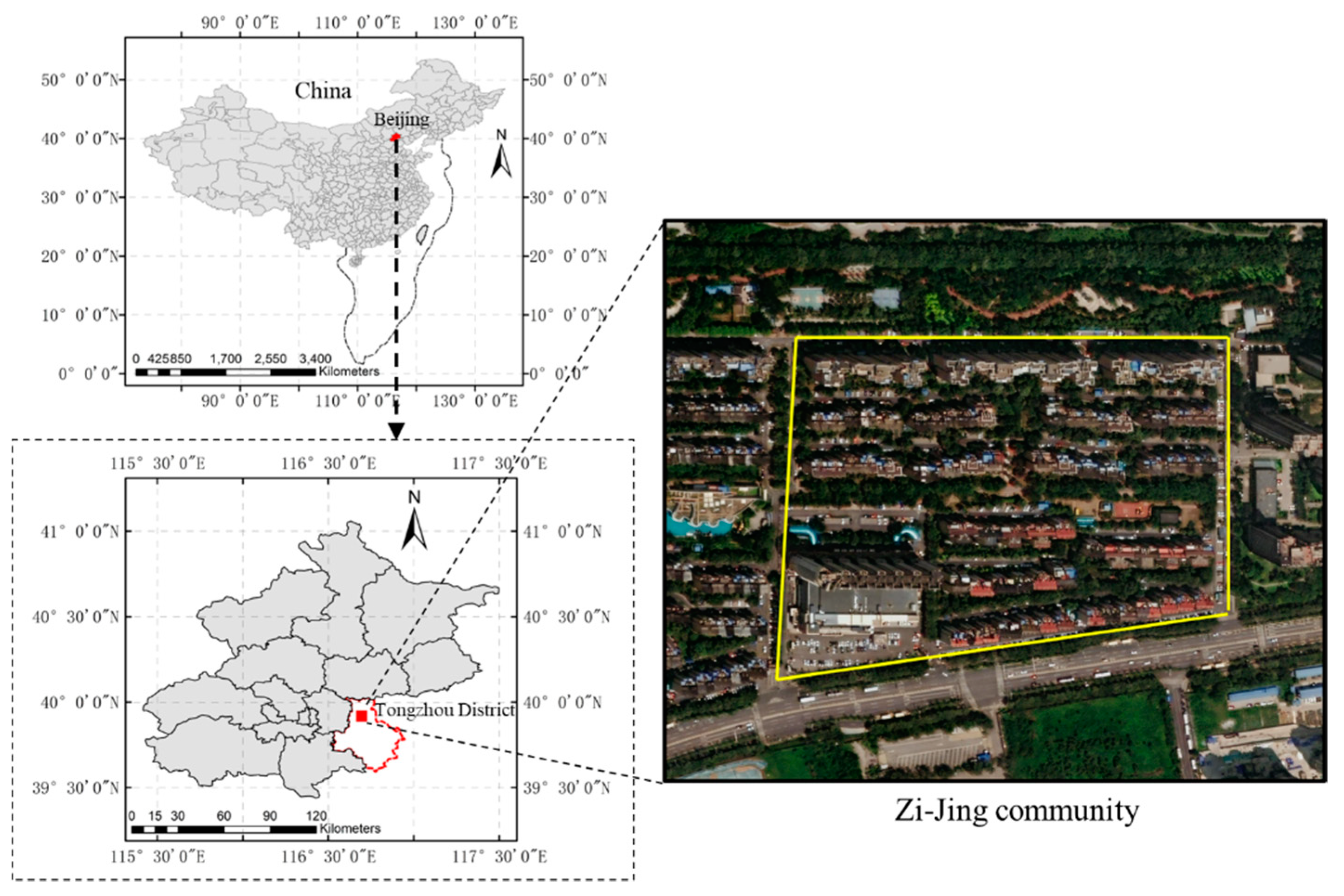

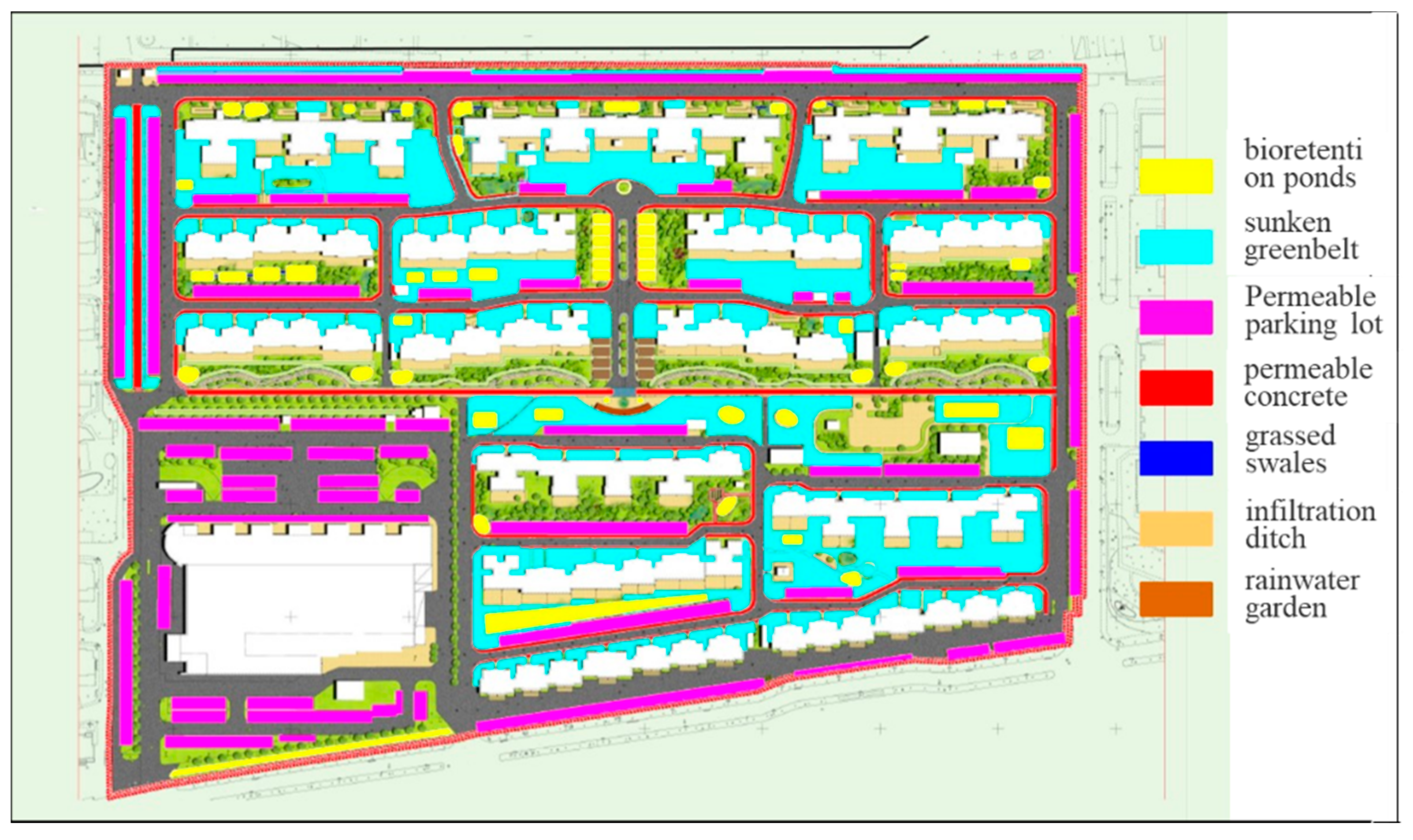
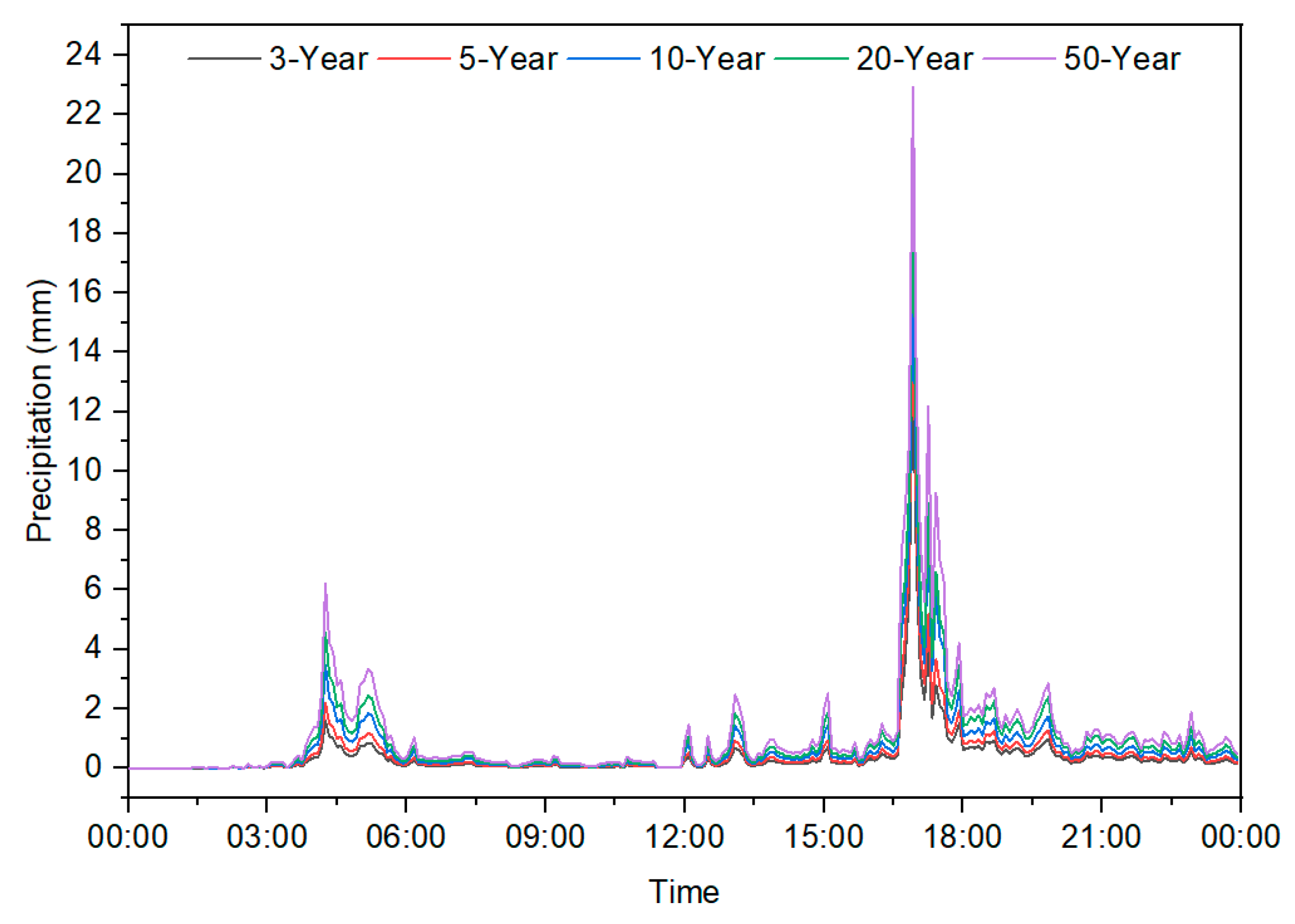
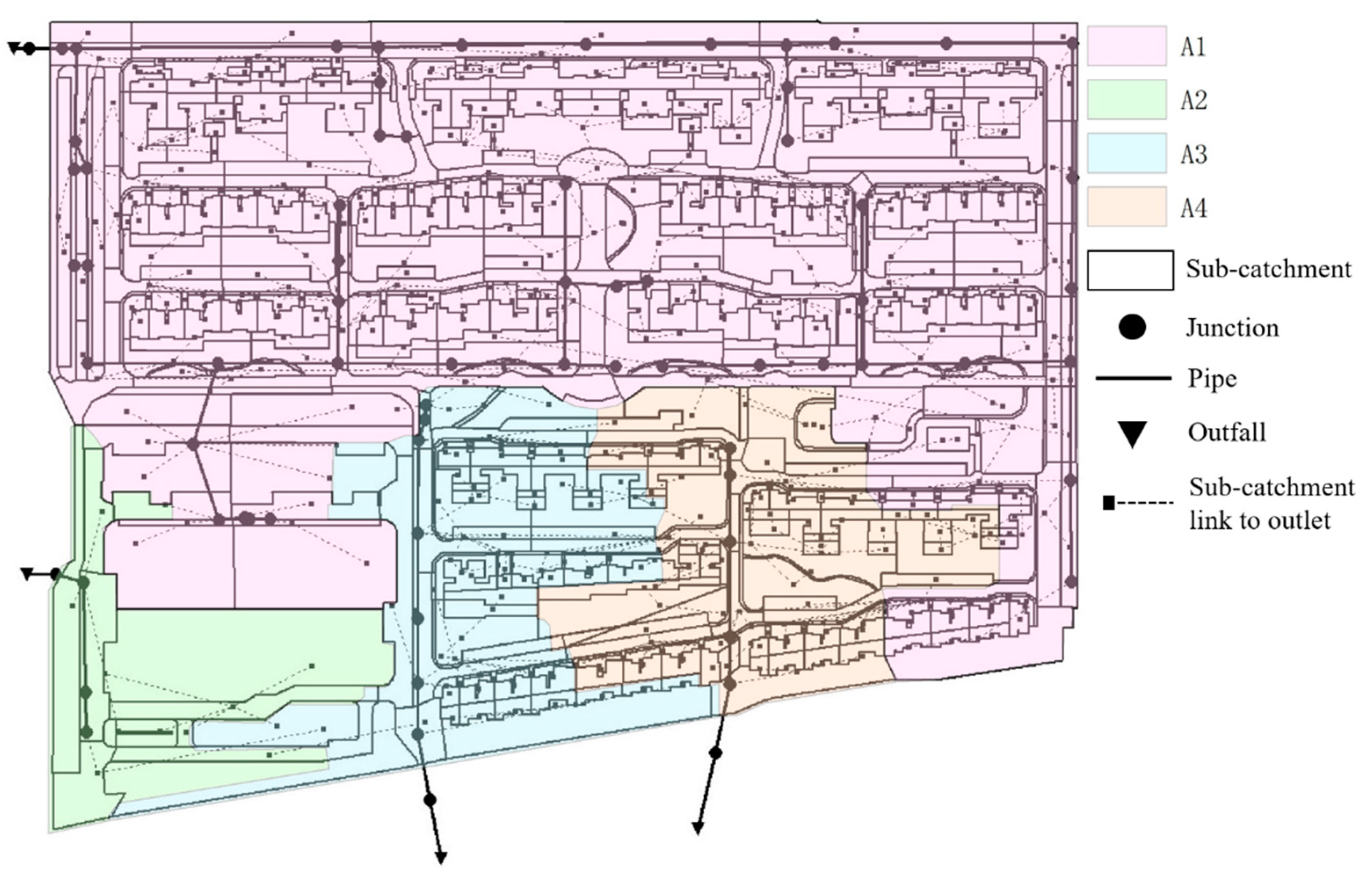
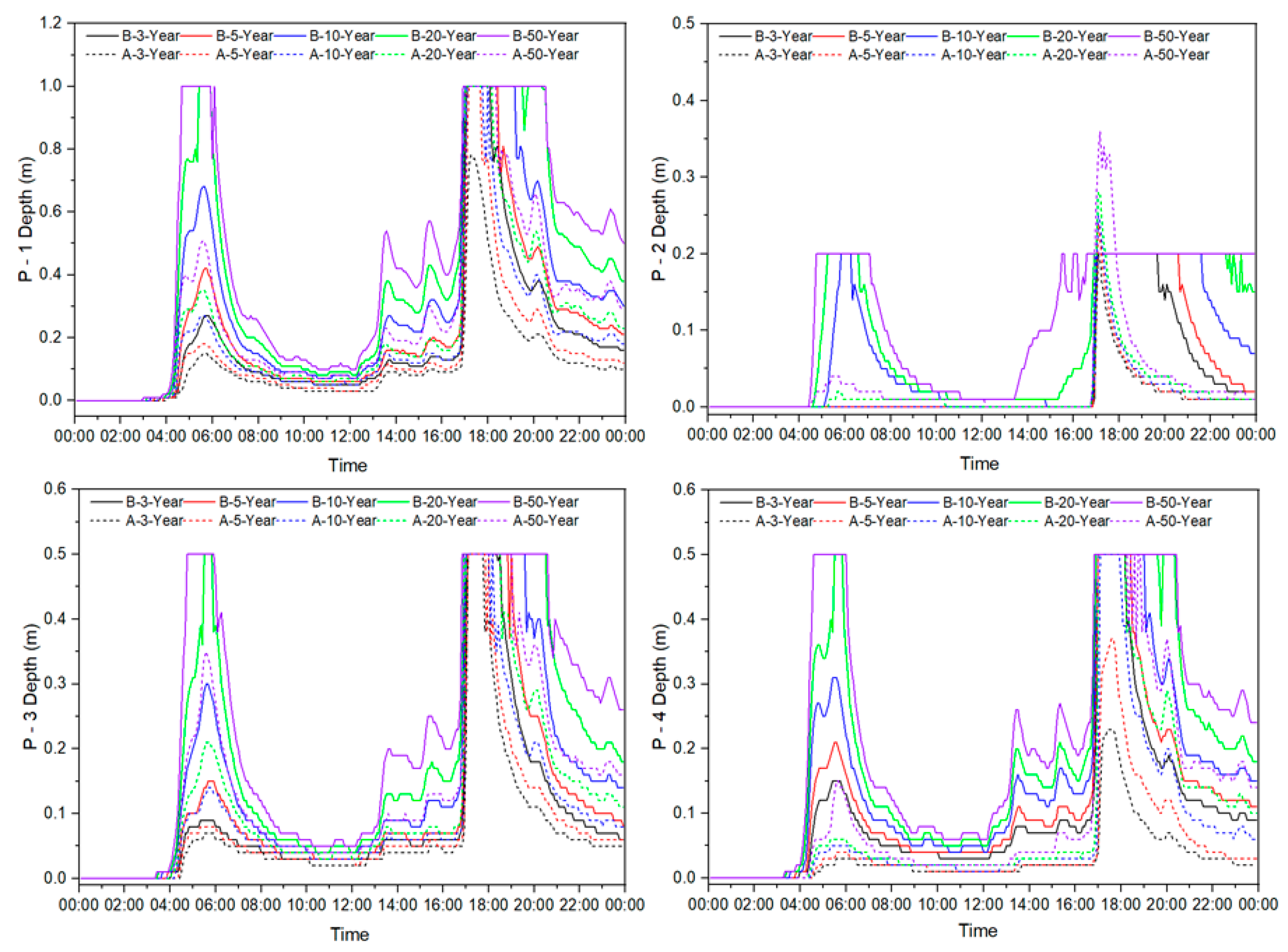
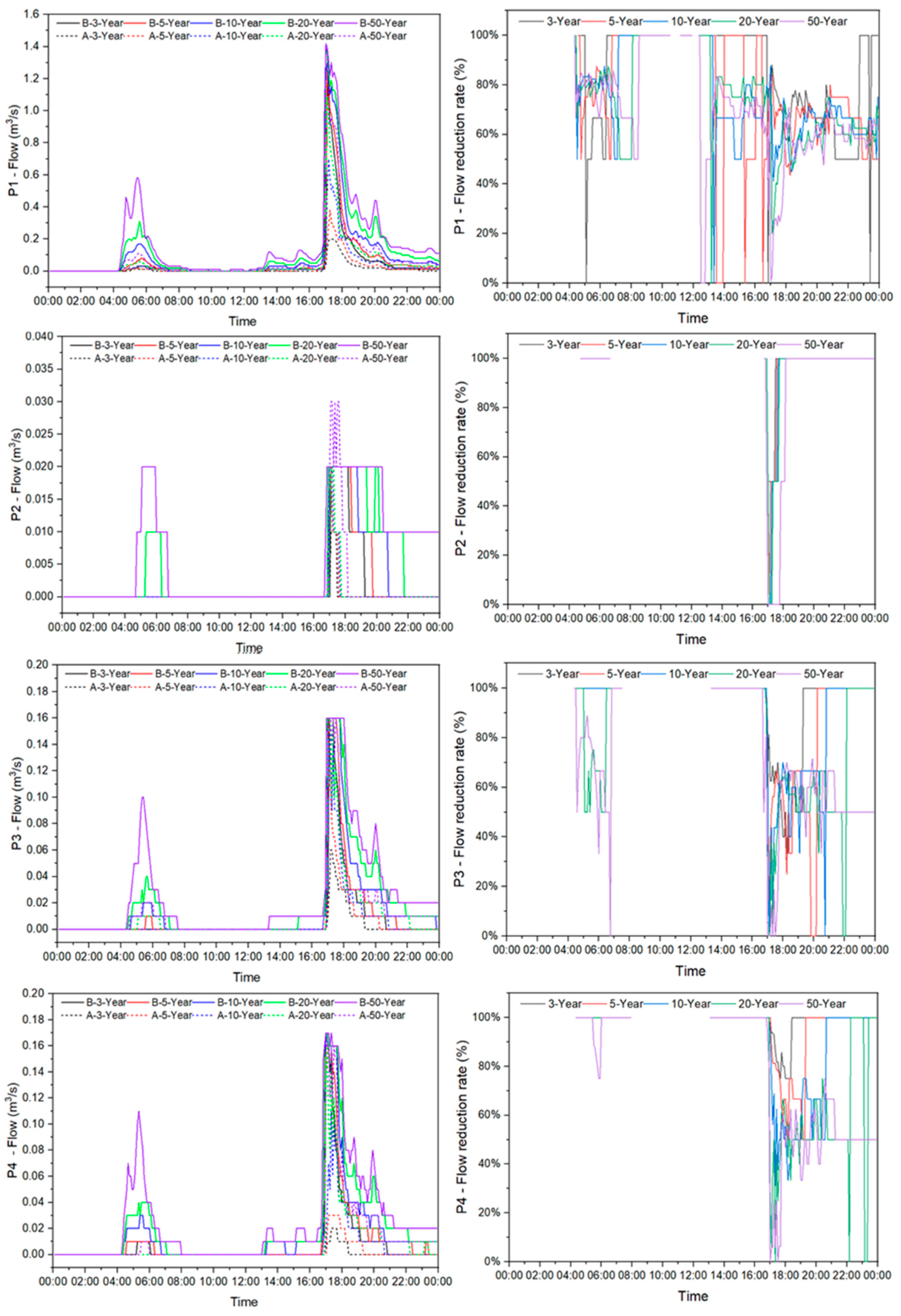
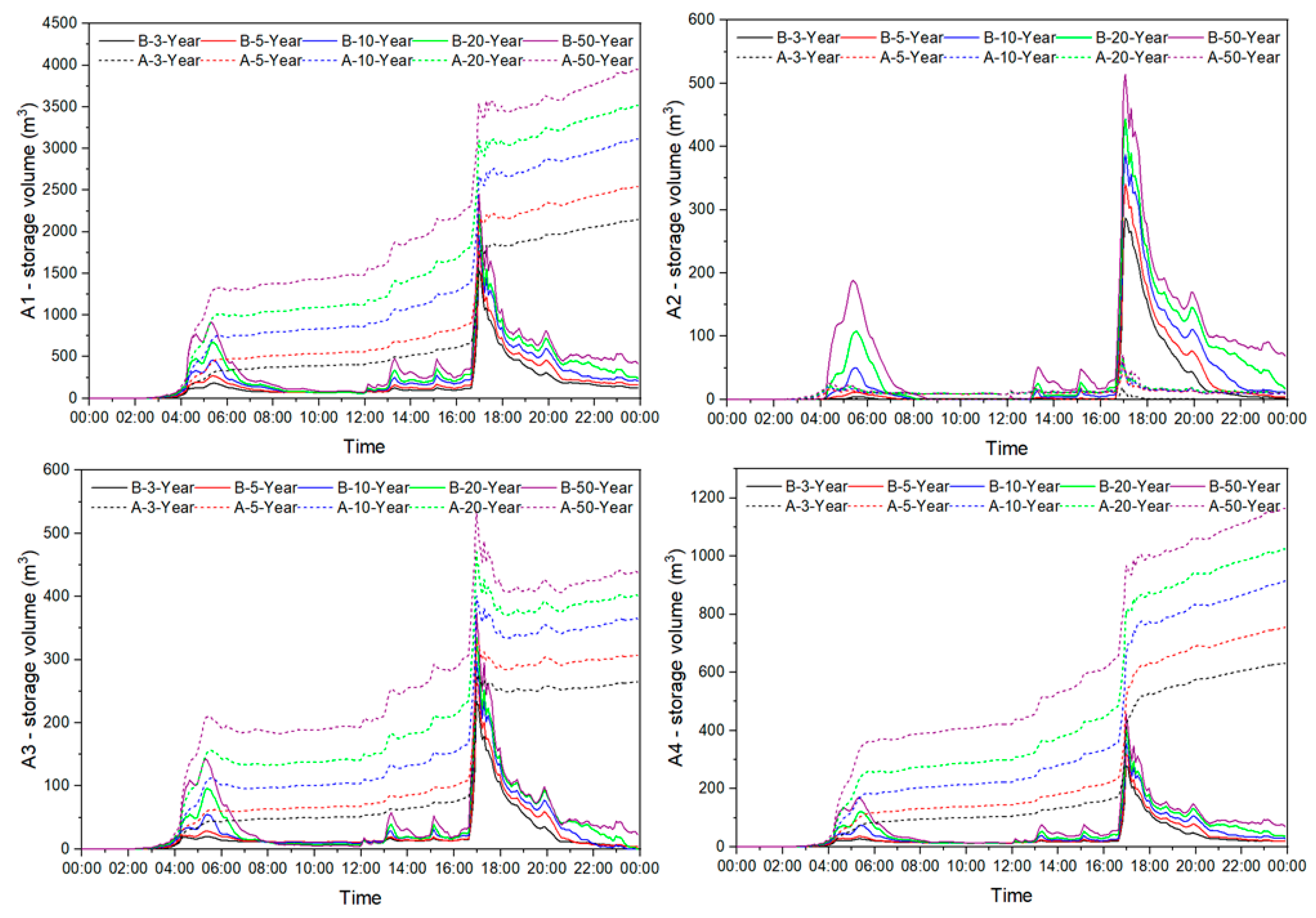
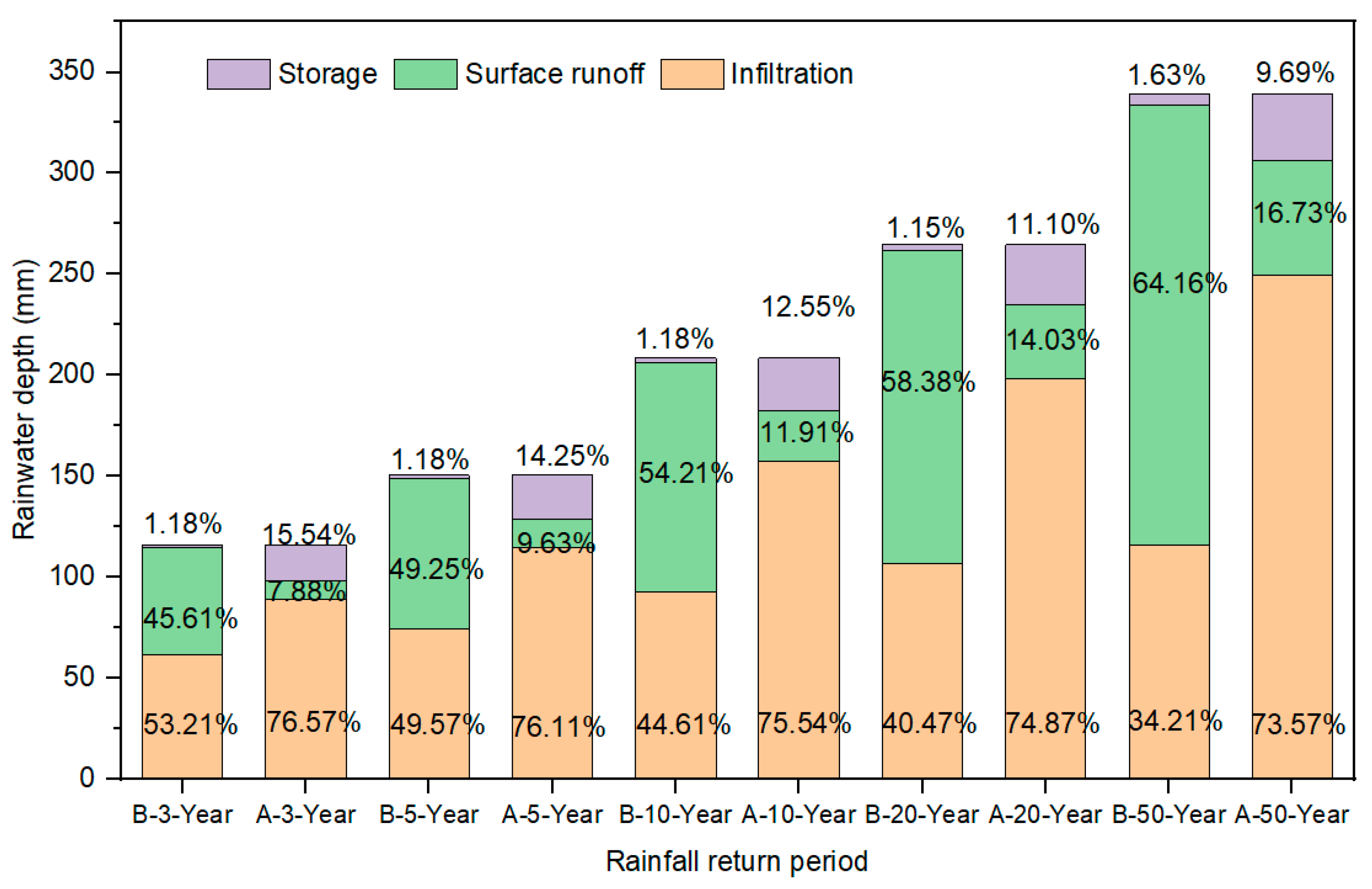
| Item | Green Land | Building Roof | ||
| Green Land (m2) | Sunken Greenbelt (m2) | Sunken Greenbelt ratio (%) | Roof (m2) | |
| Before transformation | 35,900 | 0 | 0 | 25,500 |
| After transformation | 15,300 | 20,600 | 57 | 25,500 |
| Item | Hardened Ground | Storing Rainwater | ||
| Hardened Ground (m2) | Permeable Hardened Ground (m2) | Permeable Hardened Ground Ratio (%) | Storage Pond (m3) | |
| Before transformation | 56,600 | 0 | 0 | 0 |
| After transformation | 8400 | 48,200 | 85 | 765 |
| Items | A1 | A2 | A3 | A4 | Total |
|---|---|---|---|---|---|
| Green land (m2) | 24,600 | 200 | 4500 | 6600 | 35,800 |
| Sunken greenbelt (m2) | 16,300 | 0.00 | 1200 | 3100 | 20,600 |
| Sunken greenbelt ratio (%) | 66.23 | 0.00 | 26.67 | 46.97 | 57.65 |
| Hardened ground (m2) | 36,300 | 6600 | 8900 | 4800 | 56,600 |
| Permeable hardened ground (m2) | 29,200 | 6300 | 8500 | 4200 | 48,200 |
| Permeable hardened ground ratio (%) | 80.44 | 95.45 | 95.51 | 87.50 | 85.16 |
| Roof (m2) | 16,000 | 3900 | 2600 | 3000 | 25,500 |
| Storage pond volume (m3) | 480 | 117 | 78 | 90 | 765 |
| Storage depth (mm/d) | 18.6 | 33.3 | 14.7 | 18.6 | 19.5 |
| Total area (m2) | 76,900 | 10,500 | 16,000 | 14,600 | 118,000 |
| Parameters | Meaning | Unit | Calibration Results |
|---|---|---|---|
| Slope | Mean percentage slope of sub-catchment area | % | 1.39 |
| S-Imperv | Storage depth of impervious surface | mm | 2.54 |
| NSrate- Imperv | Percentage of impermeable area without depression water storage | % | 25 |
| S-Perv | Storage depth of pervious surface | mm | 5.08 |
| Max Rate | Initial infiltration capacity | mm/h | 76.2 |
| Min Rate | Stable infiltration capacity | mm/h | 3.3 |
| Decay | Decay index of infiltration capacity | L/h | 4 |
| N-Perv | Manning coefficient in pervious area | / | Permeable pavement 0.1 |
| vegetation or green space 0.2 | |||
| N-Imperv | Manning coefficient in impervious area | / | Roof/ground:0.02 |
| Roughness | Pipeline Manning coefficient | / | 0.0147 |
| LID Facility | Parameter Name | Value Basis | Values |
|---|---|---|---|
| Bioretention ponds Sunken greenbelt Rainwater garden | Dike dam height (mm) | Design drawings | 100 |
| Soil layer thickness (mm) | 200/500 | ||
| Aquifer thickness (mm) | 400 | ||
| Vegetation volume fraction | Design criteria | 0.1 | |
| Aquifer porosity ratio | SWMM manual | 0.5 | |
| Aquifer seepage rate (mm/h) | 3.3 | ||
| Grassed swales | Dike dam height (mm) | Design drawings | 300 |
| Surface slope (%) | 1.5 | ||
| Side slope | 3 | ||
| Vegetation volume fraction | Design criteria | 0.1 | |
| Surface roughness | 0.02 | ||
| Permeable parking lot Permeable concrete | Dike dam height (mm) | Design drawings | 0 |
| Surface slope (%) | 1.5 | ||
| Surface layer thickness (mm) | 65/80 | ||
| Impermeable surface fraction | Design criteria | 0 | |
| Surface porosity ratio | Design drawings | 0.09/0.11 | |
| Surface seepage rate (mm/h) | 360 | ||
| Aquifer thickness (mm) | 200 | ||
| Vegetation volume fraction | SWMM manual | 0 | |
| Aquifer porosity ratio | 0.5 | ||
| Aquifer seepage rate (mm/h) | 3.3 | ||
| Jam factors | 0 | ||
| Surface roughness | Design criteria | 0.025/0.02 | |
| Infiltration ditch | Dike dam height (mm) | Design drawings | 50 |
| Surface slope (%) | 1.5 | ||
| Aquifer thickness (mm) | 400 | ||
| Surface roughness | Design criteria | 0.02 | |
| Aquifer porosity ratio | SWMM manual | 0.5 | |
| Aquifer seepage rate (mm/h) | 3.3 |
| 3-Year | 5-Year | 10-Year | 20-Year | 50-Year | |
|---|---|---|---|---|---|
| A1 | 19:00 | 6:30 | 5:50 | 5:30 | 5:15 |
| A2 | \ | 17:45 | 17:40 | 17:40 | 17:25 |
| A3 | 18:10 | 17:25 | 17:10 | 5:50 | 5:20 |
| A4 | \ | 17:30 | 17:20 | 17:10 | 6:25 |
Publisher’s Note: MDPI stays neutral with regard to jurisdictional claims in published maps and institutional affiliations. |
© 2022 by the authors. Licensee MDPI, Basel, Switzerland. This article is an open access article distributed under the terms and conditions of the Creative Commons Attribution (CC BY) license (https://creativecommons.org/licenses/by/4.0/).
Share and Cite
Li, W.; Wang, H.; Zhou, J.; Yan, L.; Liu, Z.; Pang, Y.; Zhang, H.; Huang, T. Simulation and Evaluation of Rainwater Runoff Control, Collection, and Utilization for Sponge City Reconstruction in an Urban Residential Community. Sustainability 2022, 14, 12372. https://doi.org/10.3390/su141912372
Li W, Wang H, Zhou J, Yan L, Liu Z, Pang Y, Zhang H, Huang T. Simulation and Evaluation of Rainwater Runoff Control, Collection, and Utilization for Sponge City Reconstruction in an Urban Residential Community. Sustainability. 2022; 14(19):12372. https://doi.org/10.3390/su141912372
Chicago/Turabian StyleLi, Wentao, Hao Wang, Jinjun Zhou, Lin Yan, Zilong Liu, Yali Pang, Haijia Zhang, and Tianyi Huang. 2022. "Simulation and Evaluation of Rainwater Runoff Control, Collection, and Utilization for Sponge City Reconstruction in an Urban Residential Community" Sustainability 14, no. 19: 12372. https://doi.org/10.3390/su141912372
APA StyleLi, W., Wang, H., Zhou, J., Yan, L., Liu, Z., Pang, Y., Zhang, H., & Huang, T. (2022). Simulation and Evaluation of Rainwater Runoff Control, Collection, and Utilization for Sponge City Reconstruction in an Urban Residential Community. Sustainability, 14(19), 12372. https://doi.org/10.3390/su141912372









